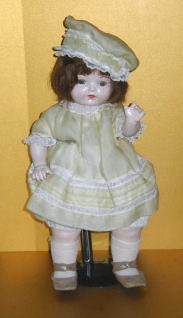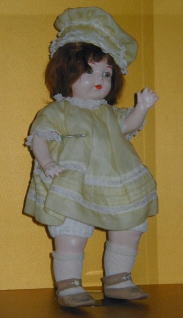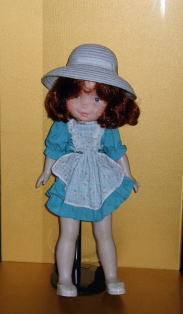
 |
Blue-eyed Dolls
What are the Blue-eyed Dolls?
The "Blue-eyed Dolls" refer to the nearly 13,000 dolls given to Japan in 1927 by American children in a program with the slogan "world peace through children." They were originally called "Friendship Dolls" in English, and in Japan this term is also used. Nowadays the term "Blue-eyed Dolls" is widely used in Japan to refer to these Friendship Dolls.
Historical Background
Japan in the early 1920s was in the midst of confusion as the economic recession grew worse due to the Great Earthquake of 1923 and the financial panic after World War I. Likewise, in America there were many unemployed people in the midst of the economic recession at that time. Therefore, there were ill feelings, social contempt, and cultural prejudice toward Japanese immigrants in America who worked hard even for low wages. American criticism of Japanese immigration increased.
Dr. Sidney Lewis Gulick (1860-1945), a missionary who was a strong supporter of Japan, wanted to try to resolve this crisis by mutual understanding and friendship between Japanese and Americans. He believed the people of both Japan and the U.S. lacked mutual cultural understanding, so in 1923 he formed the Committee on World Friendship Among Children. In order to instill a spirit of "peace and friendship" in the next generation, a "Doll Project" was initiated to plan a friendship exchange through dolls to the children of Japan, where they had a traditional annual event called Hina Matsuri (or Doll's Festival in English). This project was based on the belief that an international friendship exchange between children was needed. Many volunteers participated in this project. The number of people who cooperated in this project is said to have been 2.6 million people nationwide. In Japan the dolls were distributed by the Ministry of Education.
Japan's Response
In response to the friendship and goodwill of American children, a movement arose to send dolls also from Japan. Fifty-eight dolls, one from each prefecture, were prepared. Small contributions were solicited from the children at the elementary schools and kindergartens that had received the Blue-eyed Dolls. The Ambassador Dolls left Japan in November 1927 in order to arrive in time for Christmas.
The Ambassador Dolls arrived in San Francisco on November 25, 1927, and in Chicago on December 25. On December 27, a public welcoming ceremony was held at the National Theater in Washington, D.C., where the dolls were enthusiastically welcomed. Afterward, in connection with these Ambassador Dolls, "doll festivals" similar to Japan's Hina Matsuri were held all over the United States.
Towards War
Even though there was a friendship exchange of dolls between Japan and America, relations between the two countries gradually worsened, and they plunged into World War II in 1941. The mutual hatred between people also carried over to the dolls, and they were stabbed with spears and thrown down to the ground. Ultimately, an order that the dolls be burned was issued by the military to each school in Japan. Almost all of the dolls were burned and met the terrible fate of being reduced to ashes.
Mary
The Blue-eyed Doll kept at Hachioji Daihachi Elementary School has blond hair, is 45 centimeters tall, and is called Mary. This typical American girl's name was selected by the school children in 1980. She was discovered in 1978. The place was in the corner of a prefabricated storage shed next to the school building. She was sleeping inside a wooden box covered with dust. The reason for the discovery was that an old graduate of Hachioji Daihachi Elementary School remembered, "When we were attending the school, there was a girl doll that had come from America." Inside the box were also a message in English from the office of the Committee on World Friendship Among Children and several letters written by American elementary school children.
|
PACIFIC AND SOUTH CAROLINA AVENUES ATLANTIC CITY, N.J. Dear Friends, December 2, 1926 It was interesting to hear of your Doll Festival and we are sending three dolls to it. Two represent American girls and the other an American baby. Our happiest holiday is Christmas, which comes on the twenty-fifth of December. It is celebrated as the birth of Jesus Christ. We give to the poor so that they may have a happy Christmas. We also give presents to each other. Most of us have Christmas trees decorated with balls of many sizes, shapes and colors and with tinsel and other ornaments. The presents are generally in the same room as the tree. Beside presents we have candy. The younger children (and sometimes the older ones) hang up their stockings to be filled with candy and small presents. I wish you a very happy time at the Doll Festival. Your American friend (Grade 8) |
 |
 |
In 1987 and 1988, "New Blue-eyed Dolls" were given by Mr. Gulick, 3d, (grandson of Dr. Gulick) to schools that had kept the original Blue-eyed Dolls. Mr. Gulick, 3d, was impressed that the Blue-eyed Dolls had been kept safely in many places, and he wanted to renew and continue his grandfather's hope for peace by giving new dolls.
Becky
 |
 |
Toward the Future
The idea of the Blue-eyed Dolls that came to Japan in 1927 as messengers of goodwill and peace failed to take root in Japan in those days, and the dolls suffered sad treatment during the war. However, now our two Blue-eyed Dolls watch over the children of Hachioji Daihachi Elementary School as "symbols of friendship and goodwill" and "witnesses to history."
* * References * *
|
This is an English translation of a Japanese
web page (link no longer available).
Special thanks to Hachioji Daihachi Elementary School for permission to publish
this web page.
Return to American Blue-eyed Dolls - Individual Dolls
Return to American Blue-eyed Dolls - New Dolls
Return to 1927 Letters - America